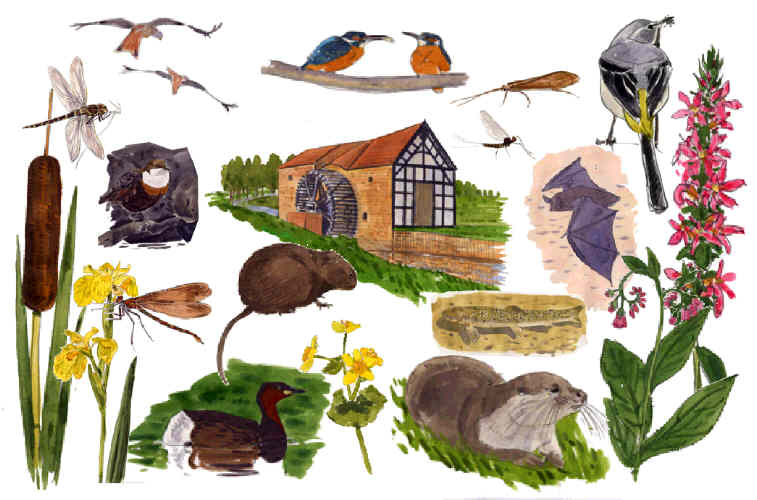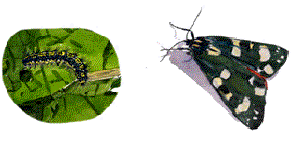 |
Kingfisher Alcedo atthis Flashes of electric blue may be all
that you see of this zippy bird. It needs soft earth banks to dig its nest
burrow and an abundant supply of small fish. Many watermills have resident
kingfishers. |
|
Dipper Cinclus cinclus Fast flowing streams below the mill race
are the likely places to find Dippers. They use their wings underwater to
swim in search of their food which is a range of invertebrates. Above water
they can be seen standing on stones, making their characteristic bobbing
movements. |
| Liitle
Grebe Tachybaptus ruficolis A compact bird which is frequently
found close to watermills. It dives underwater when disturbed and can apparently
disappear because it surfaces out of sight among bankside plants. |
| Red
Kite Milvus milvus No longer a common sight across Europe, but
making a come back in the UK. The deeply cleft tail is easily seen and helps
to separate it from its more widespread cousin, the Black Kite |
| Grey
Wagtail Motacilla cinerea An elegant wagtail that prefers swift
moving water and will often choose a nest site along the walls of weirs
and sluices. It can be seen running or fluttering after flying insects at
the water's edge. |
 |
Water
Vole Arvicola terrestris A secretive animal that lives in tunnels
under the bank: the tunnel entrance is often underwater. They eat the waterside
plants, and can sometimes be seen sitting on a floating raft of vegetation,
feasting while drifting downstream. |
| Daubenton's
Bat Myotis daubentoni European bats catch insects on the wing,
and water is the breeding ground of a wide variety of insect species. Hunting
low over the water surface is a particular speciality of Daubenton's Bat,
skilfully flying beneath bridges and entering culverts. |
| Otter
Lutra lutra A magnificent predator which swims underwater
with speed, precision and grace. 70-90% of its diet is fish, of which it
prefers to take coarse fish rather than trout because they are easier to
catch. The otter is a wary animal and you are more likely to find its territorial
marks, a frothy pile of fish bones, than to see the animal itself. |
| Brown
Trout Salmo trutta trutta A well marked fish that holds
station in the millstream by swimming just fast enough to match the speed
of the current, perhaps rising occasionally to take a fly from the surface.
If disturbed by your presence, it will dart away to shelter, returning later
to continue feeding in its favourite spot. |
 |
Dragonflies
Odonata: Anisoptera - Damselflies Odonata: Zygoptera Dragonflies
and damselflies are the most spectacular insects to be seen on a millstream
walk. The iridescent colours, flash in the sunlight as the insects are carried
through the air by their large membranous wings. The daintiness of the damselflies
is a sharp contrast to the purposeful flight of a patrolling dragonfly. |
| Mayflies
Ephemeroptera - Caddis-flies Trichoptera During the short adult
phase of their life cycle, mayflies and caddis-flies have only one objective:
to produce the next generation of their kind. To do this, they have to avoid
becoming food for the many insectivores that inhabit the waterways. Mayflies
can be seen flying close to the water, dipping their egg-laden abdomens
through the surface film. Caddis-flies often crawl below the water to lay
their eggs. |
 |
Yellow
Iris Iris pseudacorus This plant forms dense clumps in shallow
water. During early summer the large yellow flowers make eye-catching reflections
on the surface of the millpond. |
| Marsh
Marigold Caltha palustris Early in the year banks and
riverside meadows are coloured by the buttery gold of this low growing plant.
The petals shine above the rounded dark-green leaves. |
| Purple
Loosestrife Lythrum salicaria The tall purple flower spikes
are very attractive to nectar-seeking insects. It grows well in the damp
soils of the water's edge, flowering throughout the summer months. |
| Reedmace
Typha latifolia A vigorous marginal plant that can choke
streams and encroach on the open water of millponds. The flowers are the
familiar velvety brown rods that persist into the winter months. |
| Comfrey
Symphytum officinale The nodding white or pink flowers of Comfrey
sit amongst broad, hairy leaves. This is the main food plant for the hairy
caterpillar of a spectacular moth, the Scarlet Tiger Callimorpha dominula,
which is on the wing in early summer. |
|
|





